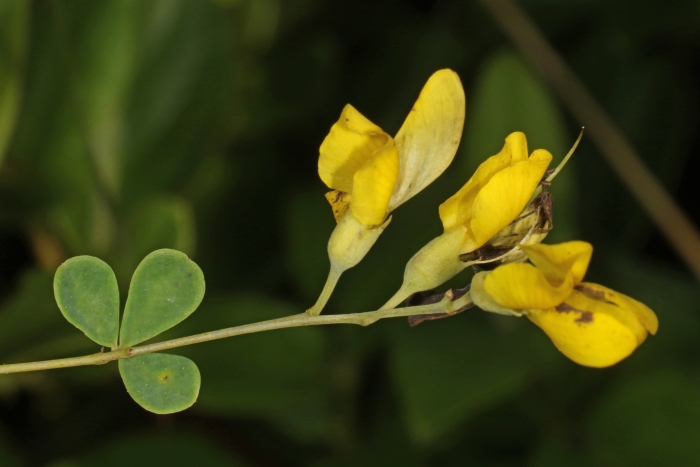Horseflyweed
(Baptisia tinctoria)
Horseflyweed (Baptisia tinctoria)
/
/

Judy Gallagher
CC BY-SA 4.0
Image By:
Judy Gallagher
Recorded By:
Copyright:
CC BY-SA 4.0
Copyright Notice:
Photo by: Judy Gallagher | License Type: CC BY-SA 4.0 | License URL: http://creativecommons.org/licenses/by-sa/4.0/ | Rights Holder: Judy Gallagher | Publisher: iNaturalist | Date Created: 2018-06-29T11:13:01-07:00 |


















































Estimated Native Range
Summary
Baptisia tinctoria, commonly known as Horseflyweed, is a deciduous perennial herb native to open woodlands, fields, and roadsides in the Eastern United States and Canada. It typically grows 2 to 3 feet tall with multiple bushy stems. The leaves are silver-green, each divided into three leaflets about ½ inch long. From late spring to early summer, it produces yellow flowers arranged in spikes that are 1½ to 3 inches long, which are followed by ornamental, inflated seed pods that add interest to the garden after flowering.
Horseflyweed is valued for its drought tolerance and low maintenance requirements, making it an excellent choice for naturalized areas, meadow gardens, and borders. It is also used in restoration projects due to its ability to fix nitrogen in the soil, improving fertility. Baptisia tinctoria prefers full sun but can tolerate light shade and is adaptable to a variety of soil conditions, provided they are well-drained. While generally pest and disease-free, it can suffer from root rot in poorly drained soils.CC BY-SA 4.0
Horseflyweed is valued for its drought tolerance and low maintenance requirements, making it an excellent choice for naturalized areas, meadow gardens, and borders. It is also used in restoration projects due to its ability to fix nitrogen in the soil, improving fertility. Baptisia tinctoria prefers full sun but can tolerate light shade and is adaptable to a variety of soil conditions, provided they are well-drained. While generally pest and disease-free, it can suffer from root rot in poorly drained soils.CC BY-SA 4.0
Plant Description
- Plant Type: Herb
- Height: 1.5-3 feet
- Width: 2-3 feet
- Growth Rate: Moderate
- Flower Color: Yellow
- Flowering Season: Summer
- Leaf Retention: Deciduous
Growth Requirements
- Sun: Full Sun
- Water: Low
- Drainage: Medium, Fast
Common Uses
Bee Garden, Bird Garden, Border Plant, Butterfly Garden, Deer Resistant, Drought Tolerant, Erosion Control, Fire Resistant, Groundcover, Low Maintenance, Rabbit Resistant, Street Planting
Natural Habitat
Open woodlands, fields, and roadsides
Other Names
Common Names: Yellow Wild Indigo, Rattleweed, Indigo-Broom, Wild Indigo, Yellow Wild Indigo, Yellow-Broom
Scientific Names: , Baptisia tinctoria, Baptisia tinctoria var. crebra, Sophora tinctoria, Baptisia gibbesii, Podalyria tinctoria, Baptisia tinctoria var. gibbesii,
GBIF Accepted Name: Baptisia tinctoria (L.) R.Br.